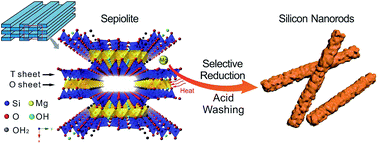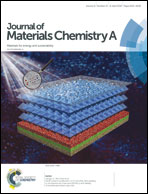Self-templating synthesis of silicon nanorods from natural sepiolite for high-performance lithium-ion battery anodes†
Abstract
Nanostructured silicon is an attractive anode material for next-generation lithium-ion batteries, but its commercialization remains a challenge owing to the energy-intensive, costly, and complex preparation of nanostructured silicon. Herein, one-dimensional (1D) silicon nanorods (SNRs) have been synthesized from natural sepiolite by a simple self-templating synthesis method. The intrinsic crystal structure and chemical composition of sepiolite allow for the maintenance of 1D structures during magnesiothermic reduction without any additional templates and heat scavengers. The as-prepared SNRs showed a large specific surface area (∼122 m2 g−1) and hierarchical porous structure (i.e., macro- and meso-pores). As anodes for lithium-ion batteries, SNRs exhibited a high reversible capacity of 1350 mA h g−1 at 1.0 A g−1 after 100 cycles, and 816 mA h g−1 at 5.0 A g−1 after 500 cycles (with a capacity retention of 98%). With a low-cost precursor and facile approach, this strategy for synthesizing 1D nanostructured Si would be promising in practical production of high-performance anode materials for lithium-ion batteries.



 Please wait while we load your content...
Please wait while we load your content...